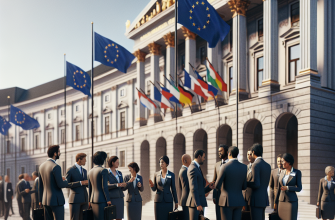- Sweden’s Refugee Policies: Embracing Change in the Face of Global Turmoil
- A Glimpse into History: The Welcoming Heart of Sweden
- Asylum Applications: The Numbers Game
- Family Reunification: A Tough Nut to Crack
- The Humanitarian Clare: Voices of Concern
- International Allegiances: Resettlement Quotas
- Incentives for Voluntary Return: A Controversial Turn
- Mental Health Challenges and the Integration Quagmire
- Conclusion: The Ongoing Balancing Act
Sweden’s Refugee Policies: Embracing Change in the Face of Global Turmoil
Oh, dear friends, as we wade through the convoluted waters of modern global conflicts, Sweden stands at the avant-garde of refugee policies. It’s a fine balancing act – an intricate ballet of immigration, integration, and humanitarian benevolence performed under the watchful gaze of a world that needs a hero. Let’s dive into the depths of how Sweden is reshaping its refugee quotas and policies amid the cacophony of ongoing strife across the globe.
A Glimpse into History: The Welcoming Heart of Sweden
Sweden has donned the cloak of a refuge since time immemorial, providing sanctuary to those fleeing the turmoil of conflicts in the Balkans, the Middle East, and Africa. But dear friends, the winds of change blow fierce! Recent developments have stirred the pot, bringing forth significant shifts in how this bastion of compassion operates.
Recent statistics reveal a shocking revelation: Sweden is poised to experience a net outflow of people in 2024 for the first time in over fifty years! Yes, you read that right. The strict immigration policies of the Swedish government have resulted in a 15% decrease in immigration and an astonishing 60% rise in emigration just within the first five months of 2024. A twist, indeed!
Asylum Applications: The Numbers Game
Now, let’s talk turkey – or rather, asylum applications. Sweden is witnessing historically low levels of these requests. In the first half of 2024, the country issued a mere fraction of residence permits compared to years past, tallying up to 5,700 fewer immigrants than emigrants. Quite the dichotomy, wouldn’t you say?
The Swedish Migration Agency has reported the breakdown; most permits issued fell into the realms of employment, family reunification, studies, and, yes, asylum. Employment reigns supreme, as a glorious 14,615 work permits have been granted to foreign talent! Bravo!
Family Reunification: A Tough Nut to Crack
In the spirit of change, the Swedish government turned the immigration policy wheel in July 2024, adding stringent measures that have made family reunification a tougher nut to crack. The spotlight now shines on creating an efficient yet restrictive framework for family immigration – an endeavor that raises eyebrows and concerns.
A special investigator has been enlisted to scrutinize the labyrinthine laws surrounding residence permits linked to family ties. This move sits under the umbrella of “sustainable immigration,” a buzzword that echoes the government’s aims of improving integration while minimizing exclusion. A noble goal, indeed, but are the ends justifying the means?
The Humanitarian Clare: Voices of Concern
Let’s not sugarcoat things, dear friends. Despite these valiant efforts, Sweden’s social services are under fire! Prolonged family separations among refugee families have ignited a fierce debate. The Syrian civil war’s toll has led to mass displacement, turning the spotlight on Sweden’s alignment with the UN Convention on the Rights of the Child in the context of these separations. Questions arise: is this the humanitarianism Sweden prides itself on?
The plight of refugee children tugs at the heartstrings, emphasizing the urgent need for swifter reunification measures. Compassion and efficiency must dance together to craft policies that truly cater to the needs of these vulnerable families.
International Allegiances: Resettlement Quotas
Drape the flag of commitment high! Sweden remains steadfast in its international duties by promising to resettle a quota of 900 refugees, with an eye on giving priority to those most at risk – women, girls, and LGBTQI individuals who face dire threats in their homelands. It’s a testament to Sweden’s unwavering dedication to equality and gender justice.
During the Global Refugee Forum in Geneva, Sweden reaffirmed its pledge to marry economic inclusion and social protection, alongside an infusion of unearmarked humanitarian funding. A noble endeavor, no doubt, as Sweden endeavors to fortify the asylum capacities of host countries globally.
Incentives for Voluntary Return: A Controversial Turn
And here comes a twist – Sweden plans to offer refugees up to $34,000 to return to their home countries starting in 2026. This new initiative is touted as part of a wider “paradigm shift” in immigration policy, aiming to mitigate the irregular migration flows that stir the pot of contention.
Swedish officials present this incentive as a beckoning hand towards voluntary return, extending an existing program with more than $3,500 in grants for immigrant families willing to leave. Logical? Perhaps. Controversial? Oh, you bet!
Mental Health Challenges and the Integration Quagmire
Let’s not forget the other side of the coin, my dear companions. The stringent border controls and new laws are casting shadows on the mental health and integration prospects of refugees. With longer waiting times for asylum examinations and processing delays, the anxiety mounts. The asylum process now slogs along at a pace of one whole year. Goodness gracious, how does one maintain sanity faced with that?
Allocation to different municipalities and switching from permanent to temporary residence permits add layers of complexity to an already convoluted narrative. Balancing the needs of refugees with the well-being of host communities is a juggling act that requires finesse.
Conclusion: The Ongoing Balancing Act
As we riffle through the pages of Sweden’s evolving refugee policies, it’s evident that change is both a friend and a foe. The Scandinavian nation continues to keep its humanitarian commitments close to its heart while navigating the inevitable internal conflicts that arise from integration challenges, family reunifications, and mental health considerations.
So, dear friends, the crux of the matter lies in finding that sweet spot between sustainable immigration strategies and the overarching humanitarian obligations that define what it means to be a refuge! The dance will continue, and we can only hope that Sweden will lead with grace and compassion.









